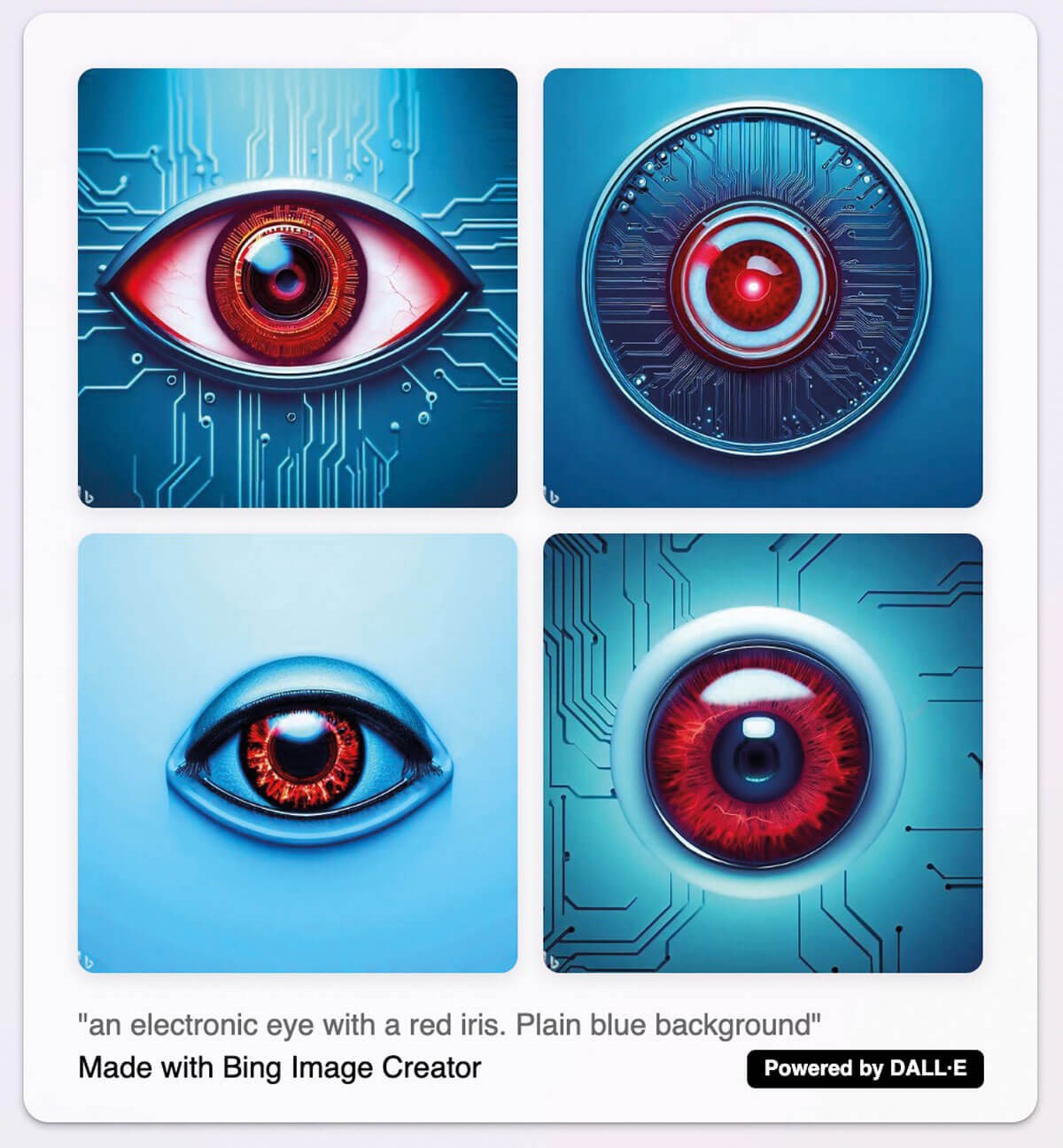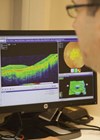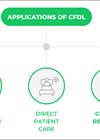It would have been hard to miss all the attention chatbots have received over the last few months. Whilst ChatGPT is easily the most well-known example of the large language models that have become so widespread of late, artificial intelligence (AI) tools are not new to medicine, or even ophthalmology.
For some years now, tools have been coming online that provide analysis of OCT imaging, especially macular optical coherence tomography (OCT) scans. This article is not about this wider AI landscape, but instead explores this explosion in publicly accessible AI chatbots. We describe the widely available options and where you might find them useful in the context of health and eye care.
The tools generate human-like responses to text-based inputs. Their responses result from exposure and training on a vast amount of data, including books, articles and websites, in order to learn the patterns and structures of language.
At the time of writing (April 2023), there are four widely accessible models available to use.
The different versions and how they compare:
ChatGPT
This was made available to the public, free of charge, late in 2022. It was trained on data up to September 2021, meaning it’s not aware of anything later. The default method of interacting with the service is via simple typed text entry and replies. These run in a conversation, with a word limit for both questions and answers of about 500 words (4096 characters). The speed of the response can be quite slow, especially at busy times of the day. The service can be accessed at: chat.OpenAI.com
ChatGPT Plus (access to GPT-4)
This is the paid service and currently costs $20 per month. The payment unlocks the ability to change the model of GPT being used, allowing access to GPT-4, which provides more accurate answers and more advanced features. GPT-4 is still limited to data up to September 2021 but is being improved frequently. The subscription also allows longer queries to be posted to the service, with ChatGPT Plus being able to consume about 25,000 words per question. This is a significant benefit when the service is being asked to analyse large chunks of code, text or data. GPT-4 can also analyse images and generate graphs and pictures, unlike ChatGPT.
Whether GPT-3 or -4, both generally provide long and detailed answers but without sharing sources or citations. If a user follows up, asking for sources of that information, GPT-3/-4 does generally do a good job in providing.
Bing Chat
Microsoft has added GPT-4 into their Bing search engine. It’s available in a separate button called ‘Chat’. Although the GPT-4 component has the same training period limit (Sept 2021), it’s hidden by Bing, as anything after that time is handled seamlessly by the underlying search engine. Bing Chat has an input limit of 2000 characters, which is the smallest of all the models. Even though it uses GPT-4, the answers Bing Chat provides are different to those from ChatGPT Plus. The answers are much shorter and less detailed, but they do share citations and sources in almost every instance, without a specific ask.

Figure 1.
This service does drop contextual advertisements into the conversation, but not in a way that is concerning or misleading. The speed of Bing Chat is fairly fast, with waits normally being no longer than a few seconds. Bing Chat also has three modes: ‘More Balanced’, ‘More Creative’ and ‘More Precise’. ‘More Creative’ ties in another AI engine called DALL•E, also made by OpenAI. This tool creates images and art. It does not search the internet for images, it creates them. For example, I asked: “draw an electronic eye with a red iris. Plain blue background”. Figure 1 shows the high-resolution results it provided.
Google Bard
Google’s offering, Bard, is not based on any of the GPT models. At the time of writing, the Bard tool was evolving quite quickly. When I first tried it, no sources were provided or available, but some have started to appear. Of the models covered, this is clearly the least mature. The answers from Bard are also lengthy and detailed, but less reliable and sometimes confusing. Bard, at least in my testing, was the fastest to respond. Like Bing Chat, it is able to answer questions about any time period and is not limited to a particular training date. Google states the tool is in development and is sometimes wrong. This was very true in my testing and often basic information was incorrect (including the current date).
What is the best tool to use?
The tools available are quite different, and there is no one size fits all. Certainly, Bard is currently the weakest and worth avoiding for now. For those that just want to experiment and test usability, I would switch between Bing Chat and ChatGPT. For quick and casual questions, Bing is great, and the Bing app for smartphones works well. For more in-depth queries I would absolutely use ChatGPT too. I would only consider trying ChatGPT Plus if you feel you could benefit from the advanced features, such as graphing and the significantly improved answers. Below is a non-exhaustive list of areas where I have found GPT useful in health and eye-care. The usual disclaimer applies, that the answers may be wrong, so treat them with caution.
Examples of healthcare uses
- Looking up conditions, medications, interactions. I found ChatGPT best for this and quicker than performing a Google search or online reading.
- Summaries of research or evidence for treatments. I asked: “What dietary supplements are used for glaucoma?” ChatGPT provided a good answer that started with “while there are some dietary supplements that have been suggested to have potential benefits for eye health, there is no known dietary supplement that has been proven to be effective in treating or preventing glaucoma.” It went on to describe a range of supplements including Ginkgo. Five-star answer.
- Symptom checking. I found the tools adequate at getting the diagnosis correct for simple ophthalmic conditions. The answers were less useful for more complex conditions.
- Analysing data from audits and studies. The tools are excellent if you feed it a table of data and ask it to calculate results, summaries, and such. None of the free tools can create proper graphs and images, but the paid GPT-4 and several third-party services based on GPT-4 can.
- PowerPoint slides. Although the tools above are unable to generate PowerPoint files, you can ask them to create slides about a certain topic. You can then cut and paste the data into PowerPoint yourself. The quality of the results depends on the topic. My wife works in data and has found ChatGPT excellent for many business and data subjects.
- Coding or scripting. I write some simple MySQL scripts to extract complex datasets from our OpenEyes EPR at my Trust. ChatGPT and Bing Chat have saved me hours already in refining these scripts to be more complete and capable.
- Summarising text. If you want a precis of an article and you have an electronic copy, try asking Bing Chat or ChatGPT to summarise it. Just paste the article or document and ask for a summary. Be mindful of the character limit on the free versions.
- Creative inspiration. Try asking “interesting topics for a glaucoma support group” – ChatGPT did a nice job of providing a comprehensive list. Also, these tools can be surprisingly good at creating patient leaflet text. If the results are too complex, ask them to re-write for a child of 10 years. The tools can also translate any text to a wide range of languages. If you are working to update the text on a website for work, these tools could give you some good starter text that you could then finesse manually.
- Research learning material or topic-specific conferences. I got a good answer when I asked for recommended conferences in Europe in healthcare and IT. A follow-up question of “how about just in the UK” was just as good.
- Travel advice. Conference to go to and like swimming? Maybe try: “can you suggest hotels in xxx with a pool at <£90/night?”
These are just a handful of ideas related to healthcare, but there is no substitute to just having a play.
Special mention: Microsoft 365 Copilot
For those that remember Microsoft Clippy (the annoying paperclip that used to help you write a letter in Word), 365 Copilot is the 2023 AI version (based on GPT-4). It promises abilities to help create PowerPoint presentations, emails, and many more Microsoft Office type jobs. At the time of writing no date has been given for the release, but Summer ‘23 seems likely – Microsoft have announced it and it is possible to try a test version for some applications. It is also unclear if it will be included in Office 365 or a paid add-on. Copilot is the word Microsoft is using for all its AI tools. Bing Chat, for example, is also described as their “Copilot for the web”.
Summary and ratings
These tools are far from perfect but already useful, even in healthcare. Treat the results with caution, and you may find they can offer you some valuable help.
Bing Chat (best free tool available) Rating: 5/5
ChatGPT (free and impressive text-based AI) Rating: 4/5
ChatGPT Plus (excellent text and graphing but paid) Rating: 4/5
Bard (potential for the future but weaker than the others) Rating: 3/5
The author has no proprietary or financial interests in the products discussed.
COMMENTS ARE WELCOME










